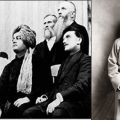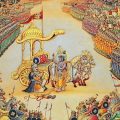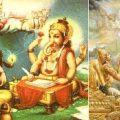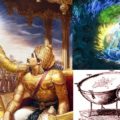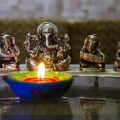Bhagavad Gita in America and Making of a Star in World Parliament of Religions
 Boston Port city in New England Region of America, traditionally has been a commercial hub for trade with India from the beginning of the eighteenth century. Cargo ships laden with spices, cotton, silk, and tea imported from China were the major cargo that were regularly shipped from India to Boston in America.
Boston Port city in New England Region of America, traditionally has been a commercial hub for trade with India from the beginning of the eighteenth century. Cargo ships laden with spices, cotton, silk, and tea imported from China were the major cargo that were regularly shipped from India to Boston in America.
Around that time India had an enviable fleet of commercial ships. More than 150 ships of 100 ton capacity and 15 ships of 1000 ton capacity. The ships built in India were regarded as ‘solid’ ships Internationally.
While the ships to America carried cargo to their capacity, the return Voyage to India was tricky, for there was no cargo to be brought back to India. Empty ships would pose stability problem, specially sailing in rough sailing conditions. Most times it was the ballast weight of stones, sand bags and sea water which had to be loaded to ensure stability.
Frederick Tudor, an entrepreneur hit upon an unique idea. Why not send blocks of frozen ice..! He was aware that the Europeans in India would welcome some iced drink. The problem of ice melting was minimized with tight sawdust packing. Needless to say that he was well rewarded for his idea. So now the return ships had Christian Missionaries and frozen ice blocks as passenger and cargo combo. This arrangement ensured stability of the ships and balance of trade.
One fine day in 1833, a ship loaded with the usual spices and other cargo set sail from Cochin to Boston. On board was a small package to be delivered to Mrs Moody Emerson. Within a few months of its arrival into Boston city, the content of this unique parcel would create a new wave of spirituality in the New England Region of America.
A copy of Bhagavad Gita translated into English was what that parcel had contained which was delivered to Mrs Moody Emerson in Boston.
Ralph Waldo Emerson, nephew of Mrs Emerson was priest in a church in Boston. Right from childhood he was spiritually inclined. Although he chose to be a priest in the church yet he was constantly searching for new meaning to life. Somehow Emerson was not happy worshipping the dead ancestors.
He neither wanted to call himself a sinner nor wanted to preach to others what he himself didn’t believe. He firmly believed the soul is very pure, all the Godliness is within. He used to discuss his dilemma with his aunt Moody Emerson. Finally he decided to quit his well paid job in the church.
Mrs Moody had heard a lot about Bhagavad Gita and many Indian scriptures. Through some common friends in India she managed to get a copy of Bhagavad Gita shipped to Boston which gifted to her nephew.
That proved to be a major turning point in the life of many like minded thinkers in not only Massachusetts but in the entire New England Region.
As the number of people who became interested in Indian scriptures, the number of books arriving from India kept swelling. Ralph Emerson and his friends then formed a club called “Transcendental Club”. This was an impetus to many others to form similar groups who passionately took to Indian scriptures.
The effect of such several groups brought in a new terminology in America, that was, “Boston Brahmins”.
Anybody who was well read and academically proficient was called by this name.
The only thing these people were longing for is to interact with an Indian who could give them a right perspective to what they have been studying. They had not seen an Indian in whole of America.
And such an” Indian Monk” that the Americans were awaiting was still six decades away. The Bhagavad Gita which was gifted to Ralph Waldo Emerson had prepared the grounds for such an epic event.
“My Dear Sisters and brothers of America” ….was how it all began.
12 October is celebrated as Columbus Day in America. On this day in 1493 he and his team of Voyagers set foot on this “New World”. They all Thought that they had landed in India, The Land of Treasure and prosperity.
For many days Columbus continued to believe that it was India and the people who greeted them with ‘arrows’ were Indians.
He had taken a huge risk with the Queen of Spain, Isabella, convincing her that he would be able to reach India by the Western Route, and he would loot India’s wealth and bring it to Spain. He even made the Queen to sign an agreement that ten percent of the loot would be his share. When Queen Isabella hesitated to make such a huge investment in such a long voyage and big scale logistical arrangements, Columbus approached the Pope of the Roman Catholic Church, who apparently had complete sway over the Royal couple. Pope also said if Columbus finds sea Route to India, it is a good idea to spread Christianity in such a vast country. The Queen then agreed to invest in such an adventure.
Now that he discovered this “New Land” not so rich like India, people not so friendly like Indians, now had to rearrange their plans. Instead of the original plan of looting they, now started establishing their own colonies by neutralising the Aboriginals. More Europeans started pouring in. “New England” was established in Eastern part by the Britishers. Spain and Portugal had their colonies. They also brought in a lot of African slaves.
Civil war broke out in the mid Eighteenth century. Industrial based North wanted to do away with slavery but farming dependent Southerners wanted the slavery System to continue. Some kind of a compromise was reached in forming “United States” by Abraham Lincoln’s efforts. With the series of discoveries of hidden wealth in terms of minerals and precious metals and with the modern factories coming up in most parts, capitalist economy holding sway, America which was found accidentally has now become a rich country.
The founder Christopher Columbus long gone, four centuries later America decided to showcase themselves to the world. Thus “Columbus Exposition”, an elaborate celebration to commemorate 400 years of American existence, was planned in 1893.
Commercial, entertainment, literature and religious activities were some of the events in that six month long celebrations.
“World Parliament of Religions ” was one mega religious congregation with delegates arriving from nearly one hundred fifty countries that comprised of 7000 various religious leaders.
One such delegate from the land of Sanatana Dharma was going through the “Karmic Circles” which perhaps was predestined before becoming the Star of Parliament of Religions.
Swami Vivekananda’s Voyage to Chicago to attend World Parliament of Religions commenced in June 1893. He boarded SS Empress from Yokohama Japan to Vancouver in Canada.
On board the ship he met Jamshedji Tata. The bond between them was instant.
The dreamer meeting The visionary.
By then Tata had already established textile industries in India. He was going to America to study the feasibility of starting steel and other industries in India.
The interaction between them gave shape to amalgamation of Resources with social welfare, research and education. This is where the idea of starting a Research Centre for Science took birth.
The idea then born, became a reality subsequently with the Graciousness of Maharajah of Mysore who donated 372 acres of land. Jamshedji Tata bearing the complete expenditure and sister Nivedita actively involving herself wholeheartedly in the project, the spacious, well equipped “Indian Institute of Science” came in to existence in 1906 in Bengaluru.
On 30 July 1893 Swami Vivekananda reached Vancouver and from there he travelled by train to Chicago, the Venue for the World Parliament of Religions (WPR).
The Responsibility of managing such a mammoth event was given to “New Religion Movement” group called ‘Swedenborgian’. Essentially this group had moved away from the rigid order of Roman Catholic Church diktat and centred their belief only around Jesus and had removed the ‘Father’ and the ‘Holy Spirit’ part. They were receptive to different Religions, belief systems and ways of worship. It was apt that such a group was the organizer of world’s religious pluralism.
Swami Vivekananda was all very enthusiastic about being a part of such a mega event, where if all goes well he would get a chance to speak about Sanatana Dharma of India. He was desperate to tell the world that our Dharma is not a mere Religion with few scriptures but a way of life followed freely without any force, restrictions or forced conversions.
But all was not going well.
On reaching Chicago he was informed that he needed to register to be a speaker and to register he needed an introductory letter from a renowned organization or a person. He didn’t have any. They said even if he had one, the last date to register was over. But what made him panic was that the event would only start on 11 September 1893, that was nearly two months away. He just didn’t have enough money to stay that long in an unknown and expensive city like Chicago.
Should he just head back to India? Or somehow stay put in America?
Some well-wishers suggested that if he stayed in smaller towns or suburbs it would be cheaper. Then he remembered the co passenger he met during the train journey from Vancouver to Chicago.
Prof Kate Sanborn. Yes she lived near Boston, had a farmhouse. “Maybe I could work in her farm to make ends meet,” he thought.
Fortunately this time around he had not lost her address.
Cause and Effect in play, the thought just flashed in his mind as he boarded the train to Boston.
When at the gate of “Breezy Meadows” which was the farm house of Prof Kate Sanborn, a tall, turbaned monk in a flowing gown appeared, Kate was ecstatic to see her revered co passenger, but soon saw the fallen shoulders, disappointment writ large on Swami’s face. She was genuinely concerned.
But let me make him feel better first, she thought. She got busy with the arrangements for his stay and meal.
Swamy kept thinking that there was no way he could ever participate in the world Parliament of Religions without an introductory letter. And who would give him such a letter?
Swami Vivekananda explained his predicament to Prof Kate Sanborn about not being able to attend the Parliament of Religions as a speaker because he didn’t have an introductory letter for registration to the Congregation. Kate thought of introducing Swami to some professors in Harvard University, someone who might help him.
Prof John Henry Wright was a well-known Academician, teaching Greek in Harvard University. He had studied Sanskrit for many years and was well versed with Indian scriptures. Kate thought he would understand Swami Vivekananda’s brilliance and help him.
On 25 August 1893, Vivekananda was invited to Prof Wright’s home to stay for the weekend. There were few friends who were spiritually inclined to meet this strangely dressed fellow from India. Due to the influence of Transcendental Club established six decades ago in Boston they were familiar with the Indian philosophy, but they had never seen an Indian before, spiritual or otherwise.
Swami was asked to tell them about India. It was a short speech about the Bhagavad Gita. The voice, intonation and mastery of English astounded them. The subject, though alien to them, was enlightening. Missionaries returning from India were giving them a very distorted version, they thought.
Kate told Prof Wright that he needed an introductory letter to attend Parliament of Religions. John Wright remarked, “To ask you, Swami, for your credentials is like asking the sun about its right to shine.”
Fortunately, Chairman of the Parliament of Religions, John Barrows was a personal friend of Prof Wright. He immediately wrote a letter to the Chairman requesting him to allow Swami Vivekananda to attend the Congregation. He also bought a train ticket for Swami to go to Chicago. His stay in Chicago was arranged in a friend’s house. It now looked like everything fell in place and finally Swami Vivekananda would attend the Congregation as a speaker.
Well, not exactly. Some more karma had to be borne – Cause and Effect.
On reaching Chicago by train, Vivekananda to his horror could not find the envelope containing all the letters and address details of organisers in Chicago.
He was devastated. Looked like he was back to square one in Chicago.
Immediate concern was shelter and food.
That night he spent in a standing railway wagon.
Vivekananda woke up in the morning hungry and frustrated. He started walking through the streets of Chicago. He had to bear the unwelcome stares of people. Completely exhausted and sad, he sat down under a tree near a Bungalow. He remembered his mother. Choked with emotions, he murmured, ‘Where are you mother?’
“Dear Mother” this is how Vivekananda addressed in his innumerable letters he wrote to Mrs Ellen George Hale.
Just as he collapsed under the tree next to a Bungalow on Dearborn Ave Street of Chicago, Mrs Hale was looking through the window, as if she expected him.
She came out of the house, looked at Swami with an expression. “So you finally came!”. She took him inside the house and introduced him to her husband George and children Mary and Harriet.
So it was Karma again in play.
He found a mother who became sheath anchor for his emotions for the rest of his life, the house became his American Headquarter, later when he would get handsomely paid for his lectures and yoga classes. The family became his Bank.
Just in an hour he was like a family member of Hale household. Mrs Hale took him to Chairman Barrow’s house in the evening and introduced Swami to him. He remembered Prof Wright’s introductory letter about an Indian Monk.
He included Vivekananda as a speaker in the afternoon session of the inaugural day, 11 September 1893.
That morning Mrs Hale Drove him to the Chicago Art Palace, the Venue for the Parliament of Religions.
Nearly seven thousand Religions Representatives had congregated there.
Being youngest in the gathering at the age of thirty, Vivekananda was representative of the world’s oldest Dharma.
In the afternoon, Chairman Barrows introduced Vivekananda to the Congregation. A little nervous in the beginning, as he rose to speak, he closed his eyes briefly, prayed to Goddess Saraswati, bowed slightly with folded hands and began his speech:
”Sisters and Brothers of America…..”
As if on a que… there was a standing ovation by all seven thousand delegates that lasted for full two minutes but the resonance stayed in the air forever.
And the Star of the World Parliament of Religions was born.
Featured image courtesy: Google.
Wing Commander Sudarshan
Latest posts by Wing Commander Sudarshan (see all)
- Evergreen Hampi: Saga of Krishnadevaraya of Vijayanagara - July 27, 2024
- What the ‘Vaimanika Shastra’ Tells about Ancient Vimanas of India - July 27, 2024
- Temple Connection of India’s Primary Education: How British Destroyed It - July 27, 2024

